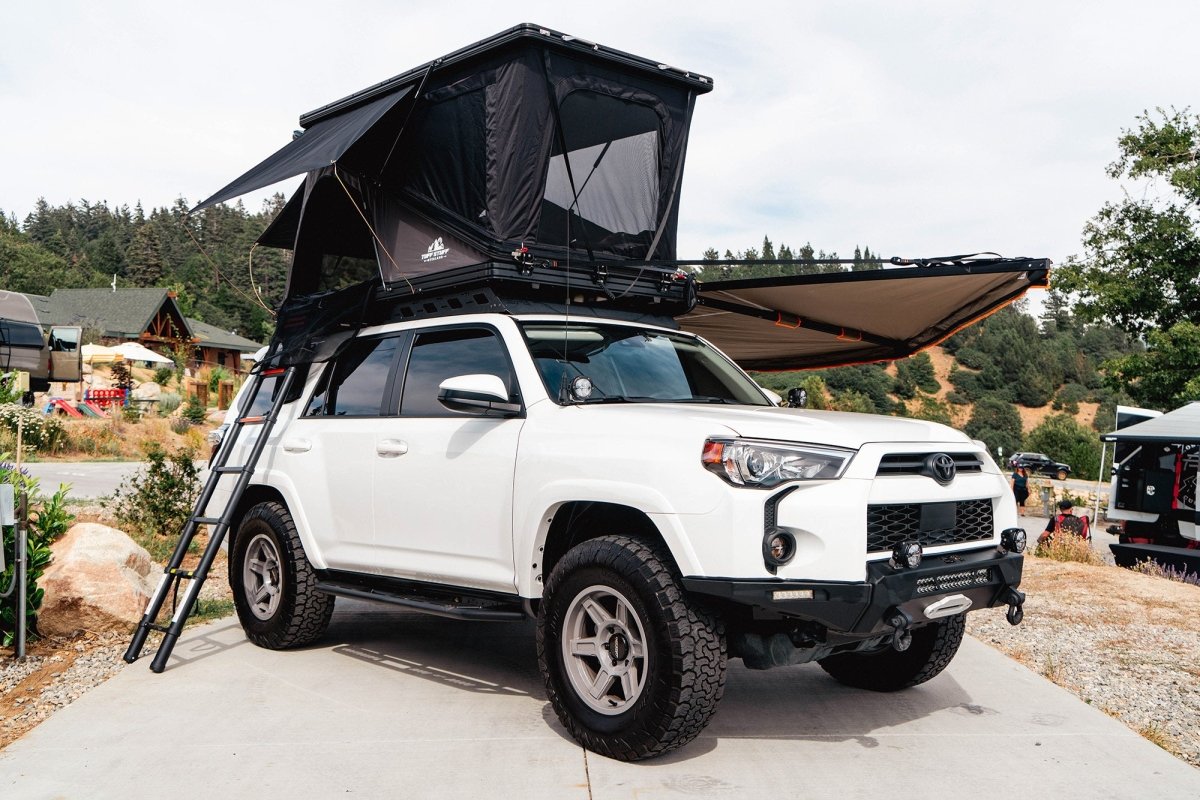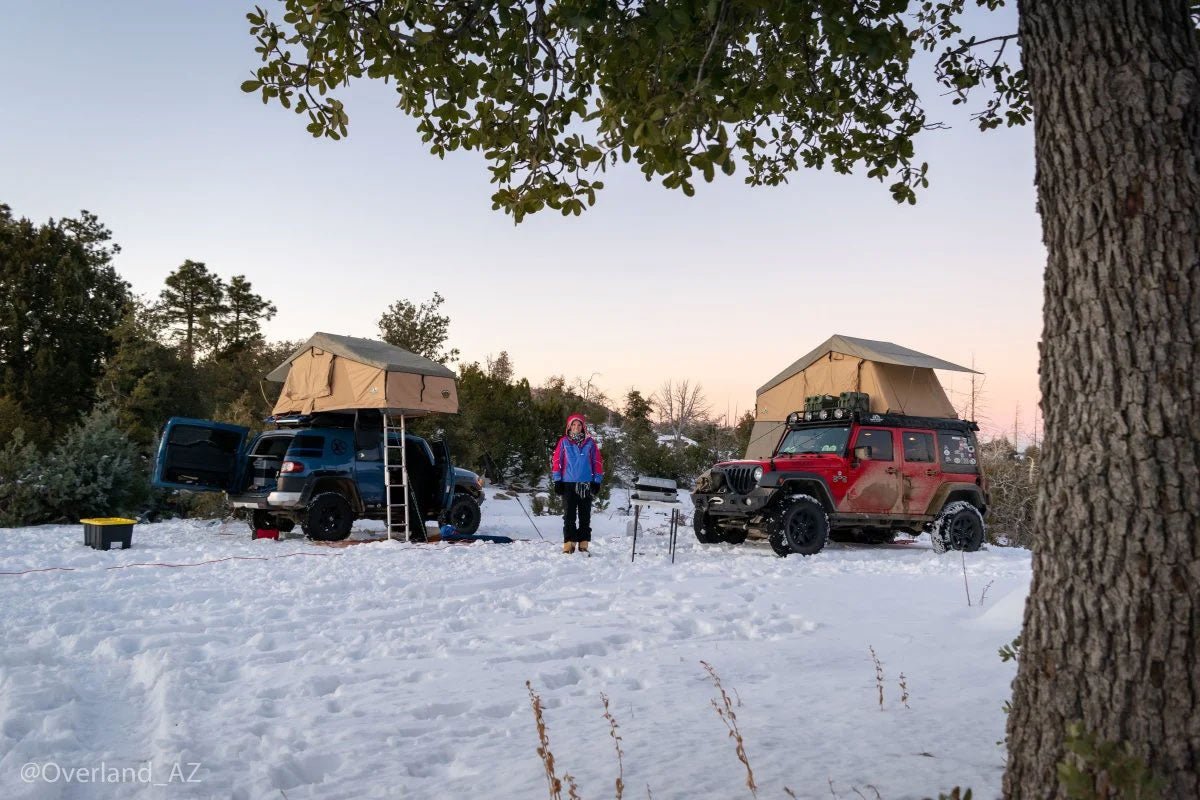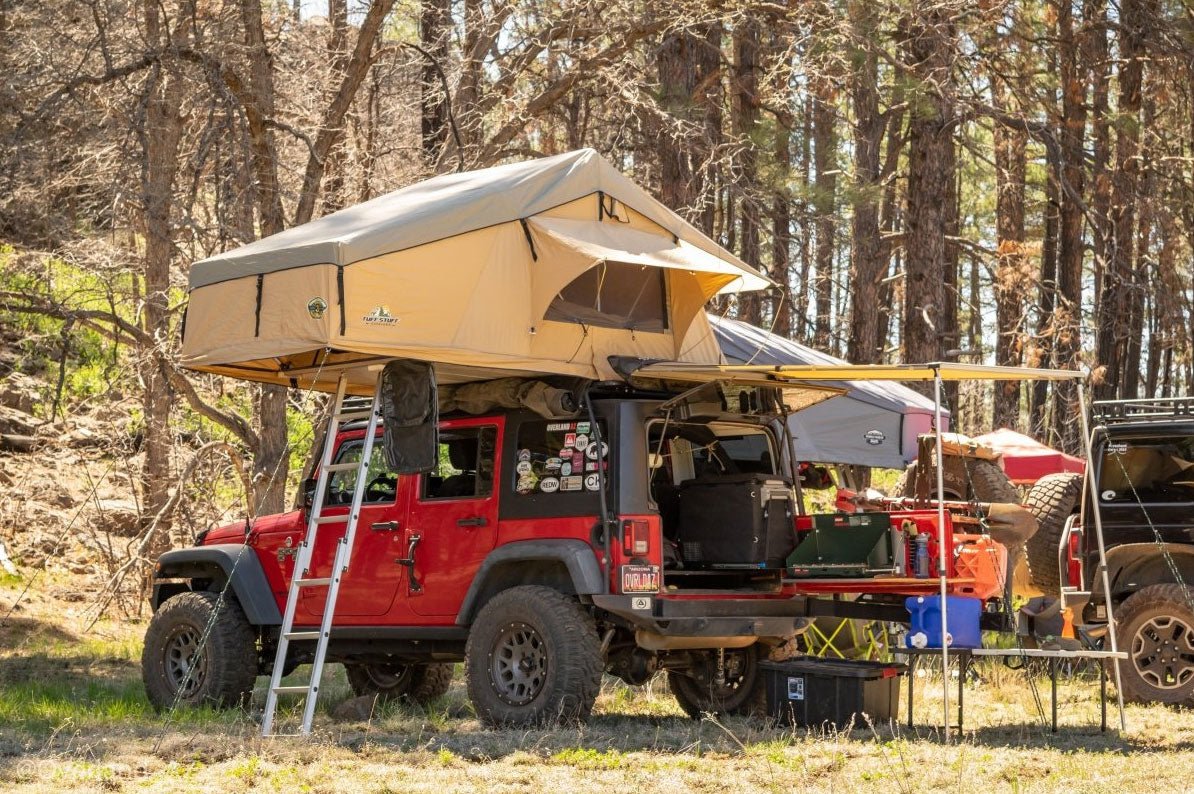When you think of going camping, the first picture that pops in your head is undoubtedly one of a camping tent erected under the sky. While camping tents are the traditional shelters for campers, there are newer and more advanced tents you can enjoy on your subsequent camping trips. One of these is the rooftop tent.
A rooftop tent is a tent that is erected on the roof of your truck or SUV. It is a game-changing essential overland camping gear that is widely becoming popular among campers and overlanders- for good reasons too! Below, we have provided reasons why a rooftop tent should become your go-to tent choice.

What Is A Rooftop Tent?
A rooftop tent is a tent erected on the roof of your camping or overlanding vehicle. Like conventional tents, it comes in various sizes, types, colors, and designs.
A rooftop tent is designed to be a convenient camping solution. Unlike a conventional tent that requires poles and knots before they can be mounted on the ground, rooftop tents can be easily mounted on the roof of your car to prepare an elevated sleeping area for you and your partner.
Rooftop tents make great travel companions because they are attached right to the top of your vehicle. This is the most crucial benefit of all.
What Are Rooftop Tents Made Of?
Rooftop tents, like any other tents, are made from different materials to suit different camping needs. The materials your tent is made from determine many features, from the weight of your tent to its season suitability.
Some fabrics rooftop tents are made from include:
- Cotton: Rooftop tents made out of 100 percent cotton fabrics are usually breathable, abrasion-resistant, and durable. They allow air to pass, making campers need extra insulation for cold and windy days. The heavier the cotton fabric used, the heavier the tent and the less breathable it is. Although cotton tents are strong, they can be challenging to dry after they get wet. They absorb moisture easily, making them difficult to use in the rain. Overall, cotton rooftop tents are great for camping in the summer.
- Polyester: Polyester rooftop tents are light, stretchy, and naturally water-resistant. They are tear-resistant and dry easily, making them an excellent choice for all seasons. While these are great, polyester tents are not breathable and suffer from abrasion easily.
- Poly-Cotton: Poly-cotton rooftop tents are made with a mixture of cotton and polyester fibers. This causes them to share the characteristic features of both fibers, quickly making them the best rooftop tent choice any camper can invest in. Poly-cotton fibers are breathable to an extent, abrasion-resistant, tear-resistant to some extent, lighter than cotton tents, and water-resistant.
- Nylon: Nylon rooftop tents are a cheaper alternative to cotton and polyester rooftop tents. They are more durable to external elements and resistant to abrasion and fire retardant. Nylon rooftop tents are light and flexible, making them easy to transport and erect. They are water-resistant, dry quickly after rainfall, and can be chemically treated to become UV-resistant.
Besides the tent material, which forms the tent canvas and offers protection, rooftop tents feature other components like the frames that give it structure and support the tent when it opens up.
How Are Rooftop Tents Mounted?
Rooftop tents are expedition-type camping tents that sit on the roof of your camping van or truck. However, contrary to what many amateur campers who are unfamiliar with rooftop tents may think, rooftop tents do not sit directly on the roof of your vehicle as this is dangerous. Instead, rooftop tents are mounted on your vehicle’s roof racks.
Rooftop tents attach to your vehicle’s existing roof rack, but in the absence of one, your rooftop tent can be mounted on separately-bought crossbars. However, before you go into the business of purchasing and mounting your rooftop tent, you need to meet specific requirements to guarantee your safety and that of your vehicle.
When purchasing your rooftop tent, you need to buy a tent that your vehicle and its racks or crossbars can support. This means you need to know your vehicle’s weight, crossbar size and weight limit, and the tent’s weight.
There are two types of tent weights which are dynamic and static weights. The dynamic weight is the tent weight supported by your vehicle when your vehicle is in motion, and the tent is not in use. The dynamic weight determines and affects your vehicle mileage, dag, and how fast you burn gas.
Static weight, on the other hand, is the weight supported by your vehicle when your tent is erect, and you are in it. The static weight is usually higher and more distributed than the dynamic weight.
After you figure out the necessary weight limits, ensure you have the right roof rack or crossbar. There are different types of roof racks and if you are buying one separately because you don't have a vehicle rack or the one on the roof of your vehicle is the wrong size, you should ensure that the one you buy is the proper size.
You should install your roof racks at least 32 inches away from each other except stated otherwise in your rooftop tent manual. To install your rooftop tent, ensure you have the proper tools and equipment. Consult your rooftop manual for instructions and get the tools required to begin the mounting process.
To install your rooftop tent:
- Ensure the tent’s components are complete. From bolts to knots and ladder brackets, ensure you have all the components listed in the manual present.
- Install the mounting tracks to the roof of your vehicle
- Secure and install the ladder
- Attach the cover
- Secure your tent to the roof as the instruction manual directs
And, voila! You have a ready-to-use tent for your subsequent camping adventures. The amount of time you need to set up your tent varies. However, as long as you have the proper tools and help needed, you can mount and install your rooftop tent in an hour or two.
Types of Rooftop Tents
There are two main types of rooftop tents and they are soft shells or hard shell rooftop tents. Soft and hard shell tents are great rooftop tent options with varying pros and cons. The features you need in your tent, like durability, space, price, and ease of setting up will help you determine what type of rooftop tent is excellent for you.
Soft Shell Rooftop Tents
Soft shell rooftop tents are lightweight and easy to transport. Although they are light, they are surprisingly considerably tricky to set up and deflate as you have to ensure every edge of the tent is secured in the cover.
Soft shell rooftop tents are an excellent option if you are looking for a rooftop tent that provides more space for accommodation. They have more room and greater floor space that can be folded out, and they also offer a space for the attachment for a separately-bought annex for more room.
Soft shell rooftop tents, however, are not an excellent aerodynamics option. They cause drag, which might slow your vehicle while driving and cause you to burn more fuel.
Hard Shell Rooftop Tents
Hard shell roof top tents feature a rigid floor and ceiling structure which makes them look like boxes. They are a standard option among campers as they are more durable than soft shell tents and are easier. However, these tents are more expensive than soft-shell rooftop tents.
Hard shell rooftop tents are often built with an aerodynamic design. This means they cause less drag resistance and do not affect your vehicle mileage as much as soft shell tents.
The rigid structure of this tent type limits the space available but makes it easier to set up in less than a minute. They are equally easy to pull down without hassle, making it possible to pack up and go.
There are different designs of hard shell rooftop tents that determine features like how your tent opens up, the structure of your tent,and your tent’s height.

Benefits of Rooftop Tents
Rooftop tents are rapidly gaining popularity as more campers begin to notice and understand the benefits of this essential camping gear. A more convenient option than conservation tents, the comfort and ease rooftop tents provide are unmatched and can be compared to none. Some reasons you should adopt rooftop tents on your next camping trip include:
1. Ease Of Set Up
When you use conventional camping tents, you first need to find a designated tent campsite to set up camp. Afterward, you need to find flat ground and clear it of stones and sticks before finally beginning the stressful process of using poles and knots to erect your tent.
With rooftop tents, you do not have to worry about these stressful processes. Since rooftop tents are mounted on the roof of your vehicle, all you need to do is find a spot to park, remove the tent cover, take the straps off, set up the ladder, and unfold your tent. You can set up your tent and be in bed in minutes.
Unlike a conventional tent that requires you to make multiple trips to your car and back, some rooftop tents can hold your mattress, pillows, and blankets even when collapsed. Even if you need to attach your annex to complete your setup, the process is easier and faster when compared to setting up a conventional tent. Setting up a rooftop tent is an effortless process that pays off after a long day of having fun in the wild.
2. Ease of Transport
If you are an overland camper or a camper who is always on the move, you will appreciate the ease of transport that rooftop tents offer. With this tent option, you can no longer be limited by terrain or location.
Rooftop tents are a practical option if you want to set up camp for the night and continue your journey in the morning. It provides a quick setup and take-down time that facilitates quick movements to different locations every day. Setting up a ground tent with poles and knots before filling it with your sleeping gear only to take it down in a few hours is an experience you don't need to suffer when you use rooftop tents.
Enjoy unconstrained camping trips to locations that will not be practical for ground tents. Whether in the forest or on rocky terrains, as long as you can find a safe spot to pack, you will have shelter over your head.
3. Above-ground Shelter
Using a rooftop tent means sleeping comfortably at a vantage point above ground level. This guarantees a comfortable night's rest away from bugs, mud, and wildlife.
Sleeping in ground tents leaves you to suffer at the hands- or bites- of buds and crawling insects. It also leaves you easily accessible to animals like snakes, compromising your safety. Sleeping off-ground level takes care of this little problem. Some rooftop tents even feature mesh panels in the window to help campers enjoy a comfortable bug-free night's rest.
Sleeping above ground level also means you can keep dirt out of your sleeping space to a great extent, especially when it rains. A ground tent will get splashed with water and mud, leaving campers to track mud in and out of their tent. With a rooftop tent, you can remain safe, comfortable, and mud-free during and after rain.
A rooftop tent is a more secure tent option that allows a camper to sleep above their truck while keeping the truck locked.
4. Comfortable Sleeping Area
If you have ever slept on a mat in a camping tent, you will agree that the feeling of rocks and pebbles poking your back isn't exactly one you enjoy on camping trips. Even if you splurge on a camping air mattress, the comfort cannot be compared to the feeling of sleeping on memory foam in a rooftop tent.
Many rooftop tents come with high-density memory foam mattresses to keep campers comfortable and warm. They also have a sturdy, flat floor surface usually made from fiberglass, steel, or any durable and strong material. This means you do not have to deal with discomfort from rocks or sticks.
5. Durability
Rooftop tents may be lightweight, but they are often made of durable and strong materials that protect the tent from damage. Additionally, they usually have solid fiberglass panels or durable aluminum frames that give the tent structure and hold it in place.
With rooftop tents, especially those made from highly durable materials, you do not have to worry about tears or abrasion. Unlike ground tents that usually have their canvas flapping in the wind or rain and even sometimes blown off the campers, rooftop tents cannot be ripped off their structure, and several designs offer minimal flapping in the wind.
Rooftop tents are heavy enough to support your problem. The canvas is more durable and guarantees the safety and security that most ground tents do not offer.
6. More Space
When using rooftop tents, you can save space in your vehicle by storing your sleeping gear in your tent, even when it is closed. With space usually a priority on camping and overland trips, you will have more space in your vehicle to pack essential camping gear.
Unlike ground tents, rooftop tents do not need to be dismantled or kept in your vehicle every morning. Since it can remain mounted on your roof and safely placed in its cover, you can save even more space in your vehicle without a problem.
Some tents, specifically hard shell tents, provide areas to store gear on their hard surface. You can solve multiple storage problems by simply investing in rooftop tents.
7. Customizable To Provide More Space
Rooftop tents can be customized to add more space by providing means of attaching separately-bought awnings, awning curtains, and annexes.
Annexes are equally durable camping equipment that provides additional shelter for a convenient private space, changing room, or kitchen setup. They come in different designs and colors and can easily be attached to your rooftop tent.
Awnings also provide extra shelter by casting a shade that helps campers create their make-shift outdoor patio. They can be fitted with curtains to provide a sleeping area below your rooftop tent.
8. Luxury
Who says you must purchase an RV to enjoy a luxurious camping trip? You can enjoy luxury in the wilderness without splurging thousands of dollars on an RV by simply investing in the correct type of rooftop tent. Rooftop tents are cheaper options that offer equally great comfort and convenience.
While, of course, you won’t enjoy running water and the customized bathroom that RVs offer, you will still enjoy electricity through solar panel fittings and the comfort and freedom of mobility that RV users enjoy. You will also get to save a lot of money!
9. Year-Round Use
All rooftop tents are made with durable materials, but some are made with heavy-duty materials that can handle all types of weather. Being able to handle different weather conditions without problems makes them viable for all-season year-round.
These rooftop tents are fitted with thick fabric, insulation, anti-condensation mats, and other features necessary to keep campers comfortable all year. This way, you can stay warm and dry in the winter and cool in the summer.
Enjoying The Unbeatable Advantages of Rooftop Tents
Rooftop tents are ten steps ahead of conventional ground tents. They are durable, affordable, and designed to offer comfort and convenience in the wild.
To enjoy the full benefits of your rooftop tent and optimize its features, it is essential to ensure it is the right fit for you and your vehicle. Do your research to choose the best rooftop tent option and enjoy a luxurious subsequent camping trip.



